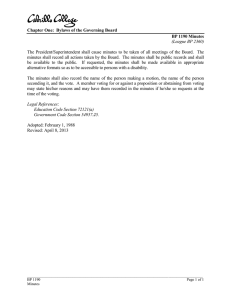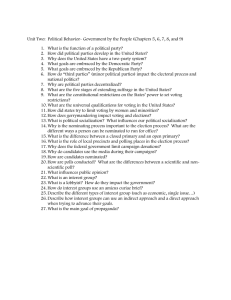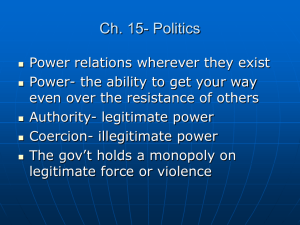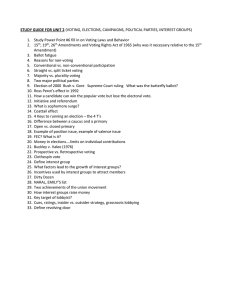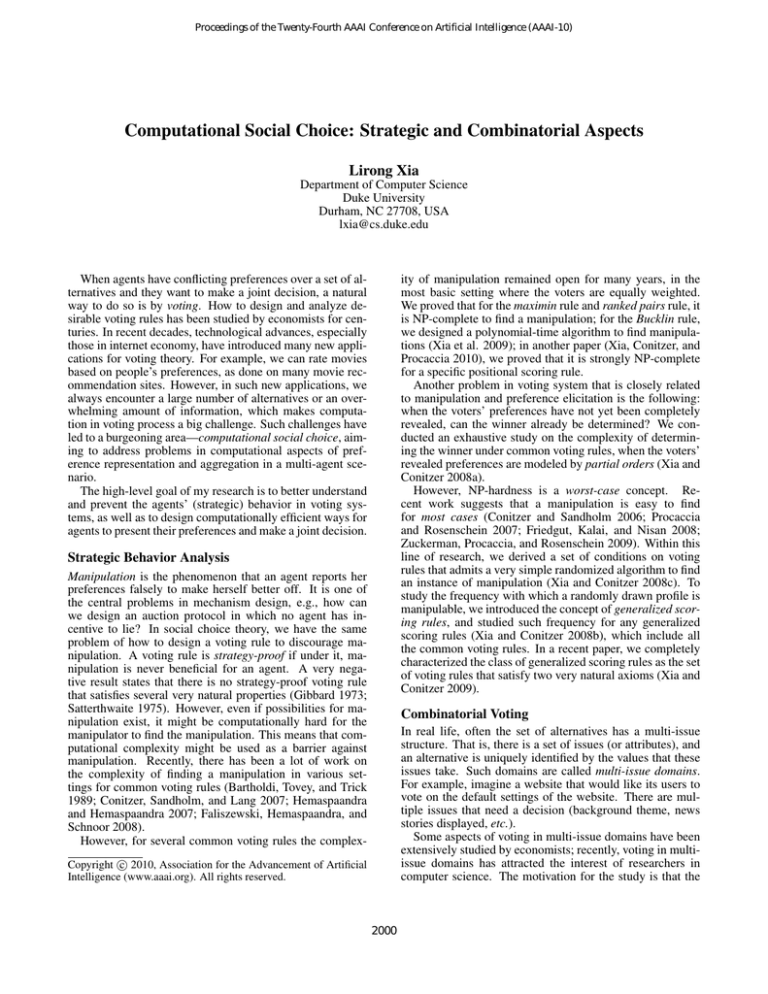
Proceedings of the Twenty-Fourth AAAI Conference on Artificial Intelligence (AAAI-10)
Computational Social Choice: Strategic and Combinatorial Aspects
Lirong Xia
Department of Computer Science
Duke University
Durham, NC 27708, USA
lxia@cs.duke.edu
When agents have conflicting preferences over a set of alternatives and they want to make a joint decision, a natural
way to do so is by voting. How to design and analyze desirable voting rules has been studied by economists for centuries. In recent decades, technological advances, especially
those in internet economy, have introduced many new applications for voting theory. For example, we can rate movies
based on people’s preferences, as done on many movie recommendation sites. However, in such new applications, we
always encounter a large number of alternatives or an overwhelming amount of information, which makes computation in voting process a big challenge. Such challenges have
led to a burgeoning area—computational social choice, aiming to address problems in computational aspects of preference representation and aggregation in a multi-agent scenario.
The high-level goal of my research is to better understand
and prevent the agents’ (strategic) behavior in voting systems, as well as to design computationally efficient ways for
agents to present their preferences and make a joint decision.
ity of manipulation remained open for many years, in the
most basic setting where the voters are equally weighted.
We proved that for the maximin rule and ranked pairs rule, it
is NP-complete to find a manipulation; for the Bucklin rule,
we designed a polynomial-time algorithm to find manipulations (Xia et al. 2009); in another paper (Xia, Conitzer, and
Procaccia 2010), we proved that it is strongly NP-complete
for a specific positional scoring rule.
Another problem in voting system that is closely related
to manipulation and preference elicitation is the following:
when the voters’ preferences have not yet been completely
revealed, can the winner already be determined? We conducted an exhaustive study on the complexity of determining the winner under common voting rules, when the voters’
revealed preferences are modeled by partial orders (Xia and
Conitzer 2008a).
However, NP-hardness is a worst-case concept. Recent work suggests that a manipulation is easy to find
for most cases (Conitzer and Sandholm 2006; Procaccia
and Rosenschein 2007; Friedgut, Kalai, and Nisan 2008;
Zuckerman, Procaccia, and Rosenschein 2009). Within this
line of research, we derived a set of conditions on voting
rules that admits a very simple randomized algorithm to find
an instance of manipulation (Xia and Conitzer 2008c). To
study the frequency with which a randomly drawn profile is
manipulable, we introduced the concept of generalized scoring rules, and studied such frequency for any generalized
scoring rules (Xia and Conitzer 2008b), which include all
the common voting rules. In a recent paper, we completely
characterized the class of generalized scoring rules as the set
of voting rules that satisfy two very natural axioms (Xia and
Conitzer 2009).
Strategic Behavior Analysis
Manipulation is the phenomenon that an agent reports her
preferences falsely to make herself better off. It is one of
the central problems in mechanism design, e.g., how can
we design an auction protocol in which no agent has incentive to lie? In social choice theory, we have the same
problem of how to design a voting rule to discourage manipulation. A voting rule is strategy-proof if under it, manipulation is never beneficial for an agent. A very negative result states that there is no strategy-proof voting rule
that satisfies several very natural properties (Gibbard 1973;
Satterthwaite 1975). However, even if possibilities for manipulation exist, it might be computationally hard for the
manipulator to find the manipulation. This means that computational complexity might be used as a barrier against
manipulation. Recently, there has been a lot of work on
the complexity of finding a manipulation in various settings for common voting rules (Bartholdi, Tovey, and Trick
1989; Conitzer, Sandholm, and Lang 2007; Hemaspaandra
and Hemaspaandra 2007; Faliszewski, Hemaspaandra, and
Schnoor 2008).
However, for several common voting rules the complex-
Combinatorial Voting
In real life, often the set of alternatives has a multi-issue
structure. That is, there is a set of issues (or attributes), and
an alternative is uniquely identified by the values that these
issues take. Such domains are called multi-issue domains.
For example, imagine a website that would like its users to
vote on the default settings of the website. There are multiple issues that need a decision (background theme, news
stories displayed, etc.).
Some aspects of voting in multi-issue domains have been
extensively studied by economists; recently, voting in multiissue domains has attracted the interest of researchers in
computer science. The motivation for the study is that the
c 2010, Association for the Advancement of Artificial
Copyright Intelligence (www.aaai.org). All rights reserved.
2000
number of alternatives is exponentially large, hence introduces many difficulties for preference representation and aggregation. Therefore, new languages for voters to express
their preferences, as well as novel voting rules to aggregate
these preferences, are desired.
One feasible solution is to use acyclic CP-nets (Boutilier
et al. 2004)—a compact language for representing preferences in multi-issue domains—to model the voters’ preferences, and sequentially apply a voting rule to each issue sequentially (Lang and Xia 2009). We have extensively studied the properties of such sequential voting processes, including how properties of issue-wise rules transfer to the
sequential voting process (and vice versa) (Lang and Xia
2009), and whether or not such sequential voting processes
satisfy some very natural properties, such as neutrality and
efficiency (Xia and Lang 2009).
To relax the restrictive constraint on the language used in
sequential voting processes, we proposed two extensions of
the sequential voting process. The first extension adopts a
language that allows voters to use acyclic CP-nets that are
consistent with a non-fixed order of issues (Xia, Lang, and
Ying 2007). The second provides a general framework for
the voters to use (possibly cyclic) CP-nets to represent their
preferences (Xia, Conitzer, and Lang 2008). For the second
extension, we designed an algorithm to compute the winner,
which is very efficient when there are strong conditional independencies among issues. We also extend the maximum
likelihood approach to voting rules (Conitzer and Sandholm
2005; Conitzer, Rognlie, and Xia 2009) to multi-issue domains (Xia, Conitzer, and Lang 2010).
Another downside of sequential elections is that the chair
can control the outcome of the election by changing the order in which issues are voted on. In a recent paper, we
showed several hardness and easiness results for the chair’s
control problem (Conitzer, Lang, and Xia 2009).
Chevaleyre, Y.; Lang, J.; Maudet, N.; and Ravilly-Abadie, G. 2009.
Compiling the votes of a subelectorate. In IJCAI, 97–102.
Conitzer, V., and Sandholm, T. 2005. Common voting rules as
maximum likelihood estimators. In UAI, 145–152.
Conitzer, V., and Sandholm, T. 2006. Nonexistence of voting rules
that are usually hard to manipulate. In AAAI, 627–634.
Conitzer, V.; Lang, J.; and Xia, L. 2009. How hard is it to control
sequential elections via the agenda? In IJCAI, 103–108.
Conitzer, V.; Rognlie, M.; and Xia, L. 2009. Preference functions
that score rankings and maximum likelihood estimation. In IJCAI,
109–115.
Conitzer, V.; Sandholm, T.; and Lang, J. 2007. When are elections with few candidates hard to manipulate? Journal of the ACM
54(3):Article 14, 1–33.
Faliszewski, P.; Hemaspaandra, E.; and Schnoor, H. 2008.
Copeland voting: ties matter. In AAMAS, 983–990.
Friedgut, E.; Kalai, G.; and Nisan, N. 2008. Elections can be
manipulated often. In FOCS, 243–249.
Gibbard, A. 1973. Manipulation of voting schemes: a general
result. Econometrica 41:587–602.
Hemaspaandra, E., and Hemaspaandra, L. A. 2007. Dichotomy
for voting systems. Journal of Computer and System Sciences
73(1):73–83.
Lang, J., and Xia, L. 2009. Sequential composition of voting rules
in multi-issue domains. Mathematical Social Sciences 57(3):304–
324.
Procaccia, A. D., and Rosenschein, J. S. 2007. Junta distributions
and the average-case complexity of manipulating elections. JAIR
28:157–181.
Satterthwaite, M. 1975. Strategy-proofness and Arrow’s conditions: Existence and correspondence theorems for voting procedures and social welfare functions. Journal of Economic Theory
10:187–217.
Xia, L., and Conitzer, V. 2008a. Determining possible and necessary winners under common voting rules given partial orders. In
AAAI, 196–201.
Xia, L., and Conitzer, V. 2008b. Generalized scoring rules and the
frequency of coalitional manipulability. In EC, 109–118.
Xia, L., and Conitzer, V. 2008c. A sufficient condition for voting
rules to be frequently manipulable. In EC, 99–108.
Xia, L., and Conitzer, V. 2009. Finite local consistency characterizes generalized scoring rules. In IJCAI, 336–341.
Xia, L., and Conitzer, V. 2010a. Compilation complexity of common voting rules. In AAAI.
Xia, L., and Conitzer, V. 2010b. Stackelberg voting games: Computational aspects and paradoxes. In AAAI.
Xia, L., and Lang, J. 2009. A dichotomy theorem on the existence
of efficient or neutral sequential voting correspondences. In IJCAI,
342–347.
Xia, L.; Zuckerman, M.; Procaccia, A. D.; Conitzer, V.; and Rosenschein, J. 2009. Complexity of unweighted coalitional manipulation under some common voting rules. In IJCAI, 348–353.
Xia, L.; Conitzer, V.; and Lang, J. 2008. Voting on multiattribute
domains with cyclic preferential dependencies. In AAAI, 202–207.
Xia, L.; Conitzer, V.; and Lang, J. 2010. Aggregating preferences
in multi-issue domains by using maximum likelihood estimators.
In AAMAS.
Xia, L.; Conitzer, V.; and Procaccia, A. 2010. A scheduling approach to coalitional manipulation. In EC.
Xia, L.; Lang, J.; and Ying, M. 2007. Strongly decomposable
voting rules on multiattribute domains. In AAAI, 776–781.
Zuckerman, M.; Procaccia, A. D.; and Rosenschein, J. S. 2009.
Algorithms for the coalitional manipulation problem. Artif. Intell.
173(2):392–412.
Future Work
Many real-life preference aggregation instances are multiissue settings, yet almost all approaches developed previously in the social choice community are encumbered by an
extremely high computational cost in this context. Therefore, preference representation and aggregation in multiissue domain is a promising new line of research, which is
of great academic interest and wide potential application.
Besides voting in multi-issue domains, I plan to develop
techniques/tools in the generalized voting rules framework,
for example, designing algorithms for finding a manipulation, and studying the complexity of storing and communicating part of the electorate’s results (Chevaleyre et al. 2009;
Xia and Conitzer 2010a). Another interesting direction is to
analyze voters’ strategic behavior in a game-theoretic perspective (e.g., in (Xia and Conitzer 2010b)).
References
Bartholdi, III, J.; Tovey, C.; and Trick, M. 1989. The computational
difficulty of manipulating an election. Social Choice and Welfare
6(3):227–241.
Boutilier, C.; Brafman, R.; Domshlak, C.; Hoos, H.; and Poole, D.
2004. CP-nets: a tool for representing and reasoning with conditional ceteris paribus statements. JAIR 21:135–191.
2001


